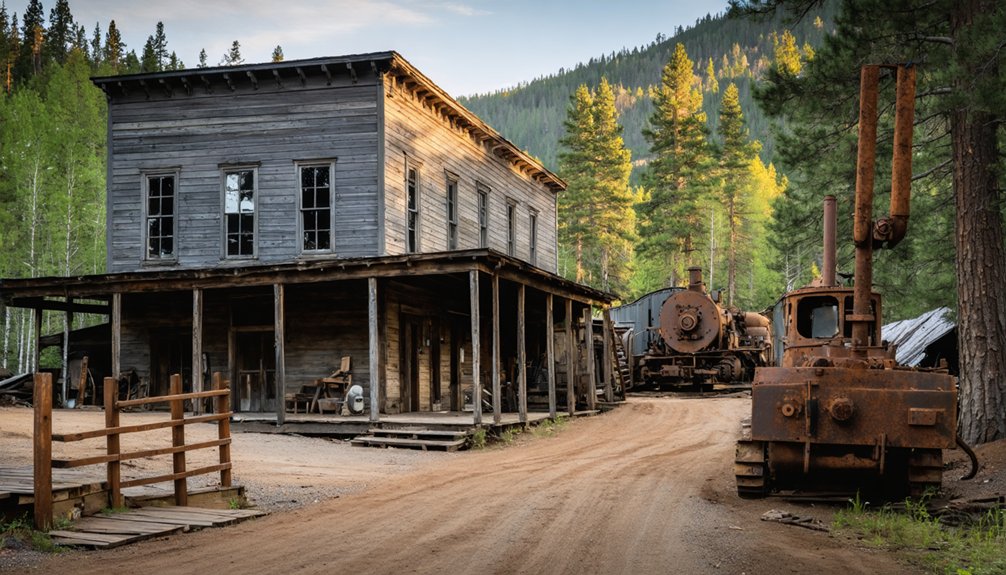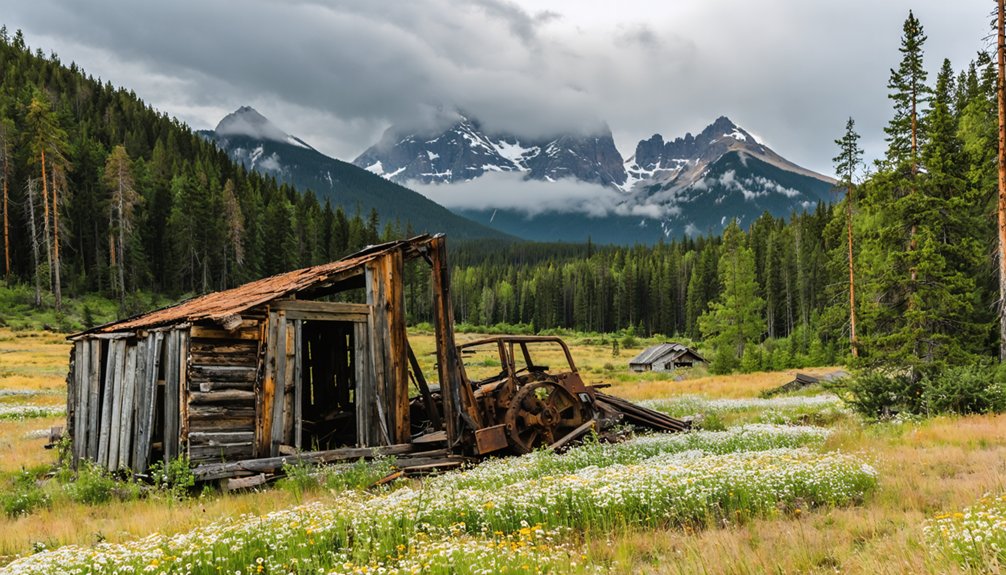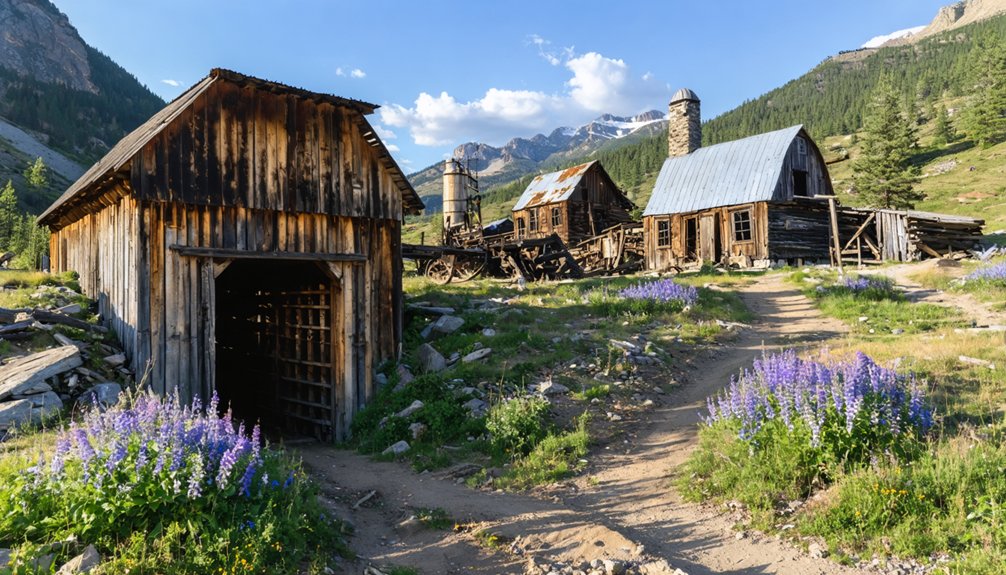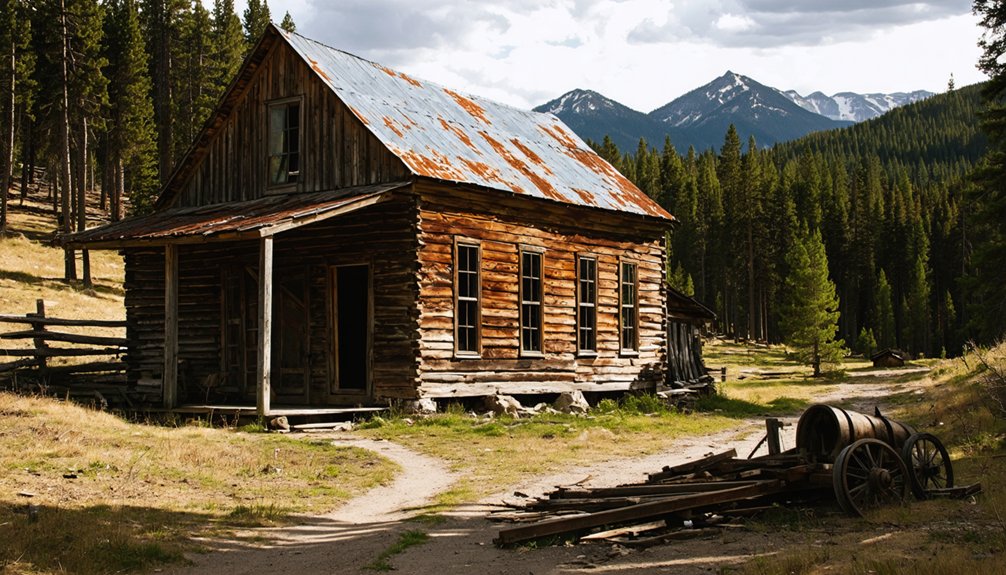You’ll find Big Creek, Idaho’s once-bustling mining town, tucked away in rugged mountain wilderness. After James Reardon and L.M. Johnson discovered rich silver deposits in 1884, the area quickly transformed from untapped mineral paradise into a thriving frontier community. The region’s mining legacy, valued at $50 billion, helped shape Idaho’s Silver Valley through the Thunder Mountain gold rush of the early 1900s. The remnants of this historic settlement hold countless tales of pioneer perseverance.
Key Takeaways
- Big Creek emerged as a mining community in 1884 after major silver and gold discoveries by James Reardon and L.M. Johnson.
- Thunder Mountain City developed as the central hub, featuring essential services like saloons, stores, and the Big Creek Ranger Station.
- The region’s mining wealth reached $50 billion, transforming the area into the “Black Basin” before its decline into a ghost town.
- Transportation evolved from 40-mile horseback rides to automobile access by 1933, connecting Big Creek to nearby Warren.
- Harsh mountain conditions, including 200-inch annual snowfall and below-freezing temperatures, significantly influenced mining operations and settlement patterns.
The Birth of a Mining Frontier
While the late 19th century saw numerous mining frontiers emerge across the American West, Big Creek’s mineral wealth remained largely untapped until 1884, when prospectors James Reardon and L.M. Johnson made their first significant mining discoveries. They uncovered an impressive 1,100-foot outcrop of parallel veins, setting the stage for Big Creek’s mining boom. Similar to the Caswell brothers who found rich placer gold further north, these early prospectors helped establish the region’s mining potential.
You’ll find that the area’s development quickly accelerated, with Silver Mountain lodes drawing London investors by 1886. Despite the promising discoveries, prospecting challenges were formidable. The region’s deep canyons and rugged terrain made exploration difficult, while seasonal snowmelt limited mining operations to brief windows of opportunity.
Yet determined miners persevered, establishing the first mining camps and roads in the late 1880s, gradually transforming this remote wilderness into a bustling frontier outpost. The establishment of Logan City in 1904 brought essential services to the area, including a four-stamp mill that began operations in 1911.
Life in Early Big Creek
If you’d lived in early Big Creek, you’d have found your daily routine centered around mining activities, with most men heading to claims at dawn to engage in ore extraction and exploration while merchants opened their shops to serve the miners’ needs.
Between shifts at the mines, you’d have gathered at the saloons and general stores that functioned as social hubs where miners exchanged news and conducted business transactions. The Big Creek Ranger Station became a vital center of community activity in the valley. Travelers could find comfort at the Cowman’s Headquarters, which offered lodging, food, and essential supplies by 1939.
You would’ve faced significant challenges during winter months, when heavy snows isolated the community and required careful planning to maintain adequate food, supplies, and fuel stockpiles.
Mining Town Daily Routines
Life in early Big Creek revolved around the demanding rhythms of mining operations, where daily routines focused on extracting gold, silver, lead, copper, and antimony from the rugged Idaho terrain.
You’d find small teams of miners, sometimes just 15 workers, heading out on horseback to their remote claims as daylight broke.
Daily labor centered around operating essential mining equipment like mills, tram systems, and hoists. You’d see arrastras grinding away at ore while workers processed materials on-site.
The intensity of work shifted with the seasons, reaching its peak during warmer months when conditions allowed for maximum production.
Dan McRae and his team spent nine years earning a stable income while working at the Dewey Mine property.
Family-run operations dominated the scene, with work schedules dictated by natural light and weather patterns rather than traditional time constraints.
Major activity in the area surged when Thunder Mountain gold rush brought more prospectors and miners to the region in the early 1900s.
Winter Survival Strategies
During Big Creek’s harsh winters, survival demanded meticulous preparation and adaptation from the town’s hardy residents. You’d need to stockpile essential supplies by late fall, mastering food preservation techniques like drying and salting to maintain provisions through the isolated months.
Winter preparedness meant gathering ample firewood for your wood-burning stove and ensuring your log cabin was properly insulated against the brutal cold. The completion of the road from Yellowpine in 1933 made winter supply runs slightly more feasible when conditions allowed.
Once snow blocked the roads, you’d rely on horses and sleds for transportation, while mail delivery became sporadic until air service began in the 1930s. Your survival skills had to include expert horsemanship in deep snow and knowledge of the local terrain to avoid getting lost in blizzards.
You’d also need to cooperate with neighbors, sharing resources when emergencies struck during the long winter isolation.
Mining Operations and Economic Impact
While early mineral discoveries near Elk Summit sparked initial interest in the Big Creek area during the late 19th century, the region’s mining operations expanded considerably after prospectors ventured into the Thunder Mountain territory.
You’ll find the area’s mineral exploration history marked by significant developments, including James Hand’s impressive Beaver Creek claim from 1893 and the extensive tunneling near Smith and Government creeks by 1898.
The district’s economic resilience became evident during its modern production phase, particularly from 1949 to 1959, when cobalt mining generated over $47.5 million in revenue.
You’re looking at a region that supported entire communities through its mining infrastructure, including underground tunnels, smelters, and processing plants.
The industry’s boom created jobs and spawned settlements like Edwardsburg, though market fluctuations eventually led to significant downturns.
Transportation and Communication Challenges
As the remote settlement of Big Creek emerged in the late 19th century, accessing the area presented formidable challenges that shaped its development. You’d have faced a grueling 40-mile horseback ride from Warren until the Edwards family constructed the first road over Elk Summit.
The transportation evolution progressed from pack animals and stagecoaches during the 1901 Thunder Mountain gold rush to automobile access via the Profile Summit road in 1933. Many travelers relied on China Springs to rest and refresh before continuing their difficult journey through the rugged terrain. Similar to other mining ghost towns across Idaho, the harsh climate helped preserve many of Big Creek’s abandoned structures.
Communication routes proved equally challenging, particularly during harsh winters when blizzards halted mail delivery. You would’ve relied on the Big Creek Post Office as your lifeline, with carriers adapting to conditions using multiple transport modes – from autos to horses to sleighs.
The isolation meant that when medical emergencies arose, you’d need to coordinate difficult long-distance evacuations through mountainous terrain.
Notable Buildings and Infrastructure

Several key structures defined Big Creek’s mining landscape, with the Big Creek Store and Ranger Station standing today as the main surviving buildings.
You’ll find historic structures scattered throughout the area, including mining shafts dating back to 1885 and remnants of the Meadow Creek Mine.
While most residential buildings have been relocated or removed, the region’s infrastructure once included mills, storage facilities, and industrial supports typical of mining communities, much like Our Lady of Tears and other historic buildings that survive in Silver City.
The transportation network features steel bridges crossing the South Fork of the Salmon River and connecting roads to Yellow Pine and Warrens.
Community remnants suggest Big Creek shared similarities with other Idaho mining towns, which typically included schoolhouses, churches, and ice houses for food storage.
The Community’s Golden Era
Following the discovery of gold in 1885, Big Creek transformed into a bustling mining community that embodied Idaho’s frontier spirit. The gold rush brought waves of determined prospectors and entrepreneurs who shaped the area’s identity, establishing dozens of mines and creating vibrant community stories that would echo through time.
- Thunder Mountain City emerged as a central hub, offering essential businesses and services to miners and travelers alike.
- The Cleveland Mine at Big Creek’s headwaters stood as a symbol of the area’s mining prominence.
- Log cabin retreats dotted the wilderness, serving both miners and outdoor enthusiasts.
- The Thunder Mountain Placer Mining Company’s establishment in 1902 marked a peak in mining investment and development.
Despite its eventual decline, this golden era left an indelible mark on Idaho’s mining heritage, preserving tales of ambition and frontier determination.
Natural Forces and Mountain Living

You’ll find that life in Big Creek was shaped by extreme mountain conditions, where winter temperatures regularly plunged below freezing and annual snowfall exceeded 200 inches at Big Creek Summit.
Wildlife encounters with elk, deer, and black bears were commonplace, forcing residents to adapt their daily routines and travel patterns to coexist with the mountain’s natural inhabitants.
The harsh climate directly impacted mining operations, as heavy snows and freezing temperatures often restricted access to mining sites and determined the mining season’s duration.
Harsh Winter Travel Challenges
While summer visitors might find Big Creek’s mountain setting idyllic, winter transforms this Idaho ghost town into a formidable landscape where survival demands extensive preparation and experience.
Winter travel becomes treacherous as heavy snowfall blankets the region, with accumulations reaching 4-6 feet. You’ll face severe isolation challenges when county authorities close access roads due to dangerous conditions.
- Whiteout conditions from blowing snow and wind gusts severely reduce visibility
- Snowdrifts block pathways and entrances, requiring constant physical clearing
- Mountain elevation of 6,500 feet extends winter’s grip well into spring
- Traditional vehicles become useless, forcing reliance on snowmobiles, tracked ATVs, or cross-country skis
If you’re considering winter access, be warned: rescue operations are dangerous and costly, with fines imposed for traffic violations during road closures.
Mountain Wildlife Encounters
Despite its ghost town status, Big Creek remains home to a remarkable diversity of mountain wildlife, including some of Idaho’s most iconic species.
You’ll find abundant wildlife sightings of elk, moose, and bighorn sheep traversing the mountainous terrain, while mountain goats display their impressive climbing abilities on rocky cliffs.
Large predator behavior is evident throughout the area, with cougars stalking the forests and black bears denning in remote zones.
You might glimpse the rare lynx in deep snow conditions or spot wolverines using high-elevation corridors.
The region’s protected forests provide critical habitat for over 142 bird species, including majestic golden eagles and peregrine falcons.
In the streams, bull trout and chinook salmon thrive, while various owl species patrol the forest canopy at night.
Weather-Shaped Mining Operations
Throughout Big Creek’s mining history, extreme mountain weather conditions shaped every aspect of its operations, from daily work schedules to long-term infrastructure planning.
You’ll find that weather variability forced mining adaptations at every turn, creating a resilient community that learned to thrive despite nature’s challenges.
- During harsh winters, you’d see miners operating in heated shelters, using specialized cold-weather equipment and lubricants to keep operations running.
- Spring thaws meant carefully managing increased runoff and potential flooding around tailings ponds.
- Summer brought ideal conditions for drilling, but you’d need to watch for fire risks in the dry mountain air.
- Year-round, you’d find residents stockpiling supplies and maintaining robust communication systems to handle weather-related isolation.
These adaptations weren’t just about survival – they represented the innovative spirit of mountain mining communities determined to succeed against natural odds.
Legacy of a Silver Rush Town

As Idaho’s Silver Valley roared to life in the late 1800s, Big Creek emerged as a pivotal player in one of the world’s most prolific silver-producing regions.
You’ll find its story began with the Blake brothers’ claims in 1884, which drew 150 enthusiastic miners to this rugged terrain. The district’s crown jewel, the Sunshine Mine, would eventually yield over 364 million ounces of silver, cementing Big Creek’s place in mining history.
Today, you’ll discover a different legacy. What was once a bustling silver mining hub has joined the ranks of Idaho’s ghost towns, leaving behind abandoned infrastructure and environmental scars.
Time has transformed this once-thriving silver town into yet another Idaho ghost town, its remains a testament to mining’s aftermath.
The region’s $50 billion mining heritage came at a steep price, transforming the pristine landscape into what locals dubbed the “Black Basin.”
Frequently Asked Questions
Are Any Original Mining Equipment or Tools Still Visible at Big Creek?
You won’t find any intact original tools or mining equipment at the site today. Historical records suggest most heavy equipment was transported away, while remaining items have deteriorated beyond recognition.
What Wildlife Dangers Did Early Big Creek Residents Face in Daily Life?
Ever wondered what lurks in mountain shadows? You’d face daily hazards from mountain lions stalking your homestead, aggressive moose weighing 2,000 pounds, and both black and grizzly bears threatening your survival.
Can Visitors Legally Explore or Metal Detect in Big Creek Today?
You’ll need special permits for metal detecting due to legal restrictions protecting the historic site. While you can explore visible remains, disturbing or removing artifacts is prohibited and heavily penalized.
Did Any Famous Outlaws or Notable Historical Figures Visit Big Creek?
You won’t find any documented evidence of famous outlaws or notable historical figures visiting Big Creek. Its history centers purely on mining activities and the hardworking families who settled there.
What Native American Tribes Originally Inhabited the Big Creek Area?
For thousands of years, you’ll find the Shoshone tribes, particularly the Sheepeaters (Tukudeka), lived and hunted here. While Nez Perce traveled nearby, they didn’t permanently settle this high mountain region.
References
- http://www.ruralnetwork.net/~yptimes/page14.html
- https://yellowpinetimes.wordpress.com/2019/01/13/idaho-history-jan-13-2019/
- https://www.ghosttowns.com/states/id/bigcreek.html
- https://www.bigcreeklodgeidaho.com/history/
- https://hicksfamilyhistory.com/2025/05/06/ghost-towns-come-alive/
- https://history.idaho.gov/wp-content/uploads/2018/08/0064.pdf
- https://en.wikipedia.org/wiki/Big_Creek
- https://objects.lib.uidaho.edu/taylorarchive/b4-HistoricalAccounts-008.pdf
- https://yellowpinetimes.wordpress.com/2019/05/05/idaho-history-may-5-2019/
- https://www.isu.edu/digitalgeologyidaho/n-idaho-mining/



